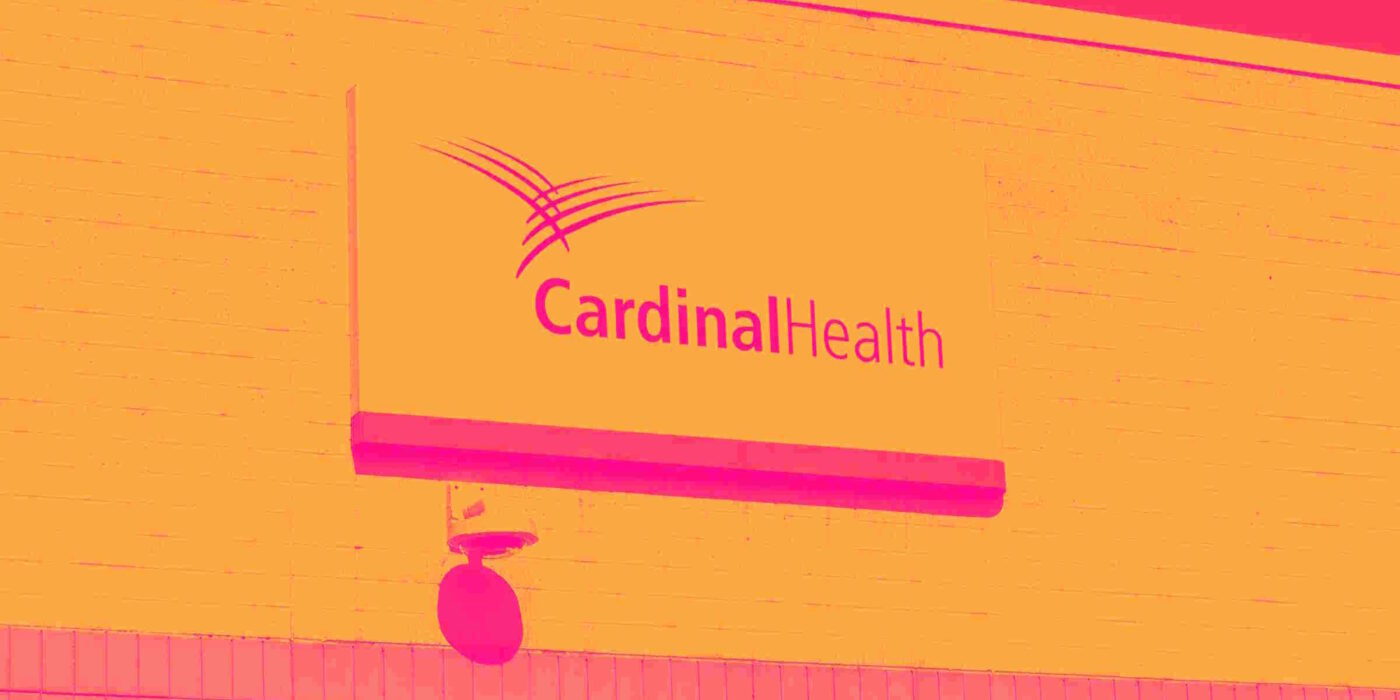
Healthcare distributor and services company Cardinal Health (NYSE: CAH) fell short of the market’s revenue expectations in Q1 CY2025, with sales flat year on year at $54.88 billion. Its non-GAAP profit of $2.35 per share was 9.4% above analysts’ consensus estimates.
Is now the time to buy CAH? Find out in our full research report (it’s free).
Cardinal Health (CAH) Q1 CY2025 Highlights:
- Revenue: $54.88 billion vs analyst estimates of $55.46 billion (flat year on year, 1% miss)
- Adjusted EPS: $2.35 vs analyst estimates of $2.15 (9.4% beat)
- Adjusted EBITDA: $849 million vs analyst estimates of $876.8 million (1.5% margin, 3.2% miss)
- Adjusted EPS guidance for the full year is $8.10 at the midpoint, beating analyst estimates by 1.7%
- Operating Margin: 1.3%, in line with the same quarter last year
- Free Cash Flow was $2.79 billion, up from -$161 million in the same quarter last year
- Market Capitalization: $35.42 billion
StockStory’s Take
Cardinal Health’s Q1 results reflected a business in transition, as revenue came in just below Wall Street expectations while non-GAAP profit surpassed analyst forecasts. Management pointed to continued growth across its Pharmaceutical and Specialty Solutions segment, contributions from recent acquisitions, and operational improvements in its Global Medical Products and Distribution (GMPD) business as key performance drivers. The company also highlighted progress in onboarding new customers and expanding higher-margin services, which offset some external headwinds.
Looking ahead, Cardinal Health raised its non-GAAP EPS guidance for the year, citing strong demand for specialty pharmaceuticals, growth in at-Home Solutions, and early benefits from the integration of Advanced Diabetes Supply Group. Management noted ongoing cost control efforts and investments in U.S. manufacturing and automation, but remained cautious about tariff-related risks and the impact of regulatory changes. CEO Jason Hollar emphasized that, “the largest and highest growth parts of our business are resilient and well positioned to continue growth,” while acknowledging the company’s focus on mitigating the financial impact of tariffs in GMPD.
Key Insights from Management’s Remarks
Management attributed the quarter’s performance to resilient pharmaceutical demand, effective cost control, and growth in targeted business areas. The company’s ability to manage through supply chain challenges and tariffs, while integrating new acquisitions, was a recurring theme.
- Specialty segment momentum: Growth in specialty pharmaceuticals and new customer onboarding, including the successful addition of Publix, drove segment profit. Specialty now represents a growing portion of the overall business mix, aided by acquisitions of GI Alliance and Integrated Oncology Network.
- GMPD turnaround progress: The GMPD segment saw improved profitability from operational efficiencies and cost reduction initiatives, with Cardinal Health branded products showing above-average growth compared to national brands.
- Tariff mitigation strategies: Management discussed aggressive steps to reduce tariff exposure, including expanding U.S. manufacturing, diversifying supply chains, leveraging tariff exemptions (such as the Nairobi protocol), and using artificial intelligence for compliance and planning. Most tariff costs in GMPD are expected to be addressed through operational actions and selective price adjustments.
- Integration of acquisitions: The company reported early positive contributions from GI Alliance, Integrated Oncology Network, and the Advanced Diabetes Supply Group, particularly in expanding higher-margin revenue streams and specialty care capabilities.
- Growth in high-margin segments: Other growth businesses, including At-Home Solutions, Nuclear, and OptiFreight, delivered double-digit profit growth. Management highlighted secular trends such as increased outpatient care and the demand for nuclear medicine as supportive of future performance.
Drivers of Future Performance
Cardinal Health’s management anticipates continued earnings growth driven by demand for specialty pharmaceuticals, ongoing cost discipline, and successful integration of recent acquisitions, but flagged tariffs and regulatory actions as areas of uncertainty.
- Specialty and biologics expansion: The company expects further growth in specialty pharmaceutical distribution, including both upstream (manufacturer partnerships) and downstream (services to physician practices) businesses, bolstered by recent acquisitions.
- Tariff exposure and mitigation: While most business lines are not significantly impacted by tariffs, GMPD remains exposed. Management aims to offset the majority of gross tariff costs through cost-cutting and price adjustments, but some uncertainty remains regarding regulatory changes and the final financial burden.
- Operational investments: Strategic investments in automation, technology, and U.S.-based manufacturing are intended to improve efficiency and support long-term growth, while integration of new businesses (such as Advanced Diabetes Supply Group) is expected to enhance profitability and expand the service portfolio.
Top Analyst Questions
- Lisa Gill (JPMorgan): Asked about sustainability of specialty and branded sales growth; management pointed to broad-based demand and consistent growth across product lines, noting that recent customer wins are expected to support ongoing momentum.
- Allen Lutz (Bank of America): Questioned whether tariffs or macroeconomic weakness were affecting prescription volumes; CEO Jason Hollar replied that pharmaceutical demand remains resilient even during broader economic downturns, citing historical trends.
- Joanna Dynak (Evercore ISI): Requested details on Cardinal Health branded GMPD revenue and tariff recovery; management declined to share profit mix specifics but noted strong branded product growth and ongoing use of tariff exemptions.
- Eric Percher (Nephron): Sought clarification on how much of the $200–$300 million in GMPD tariff costs could be offset by pricing; management expects the majority to be addressed through price increases, especially on Cardinal Health branded products.
- Daniel Grosslight (Citi): Asked about the practical ability to pass on price increases given customer contracts; management said most price adjustments would follow operational mitigation, and efforts would focus on collaboration with customers to avoid supply disruptions.
Catalysts in Upcoming Quarters
Looking ahead, the StockStory team will monitor (1) Cardinal Health’s ability to sustain specialty pharmaceutical growth and integrate new customer wins, (2) the effectiveness of tariff mitigation strategies within GMPD, and (3) progress in expanding higher-margin businesses such as At-Home Solutions and Nuclear. Updates at the upcoming Investor Day and further color on regulatory or tariff actions will also be important indicators of future performance.
Cardinal Health currently trades at a forward P/E ratio of 17×. Is the company at an inflection point that warrants a buy or sell? The answer lies in our free research report.
Our Favorite Stocks Right Now
The market surged in 2024 and reached record highs after Donald Trump’s presidential victory in November, but questions about new economic policies are adding much uncertainty for 2025.
While the crowd speculates what might happen next, we’re homing in on the companies that can succeed regardless of the political or macroeconomic environment. Put yourself in the driver’s seat and build a durable portfolio by checking out our Top 5 Strong Momentum Stocks for this week. This is a curated list of our High Quality stocks that have generated a market-beating return of 176% over the last five years.
Stocks that made our list in 2020 include now familiar names such as Nvidia (+1,545% between March 2020 and March 2025) as well as under-the-radar businesses like the once-micro-cap company Tecnoglass (+1,754% five-year return). Find your next big winner with StockStory today.





